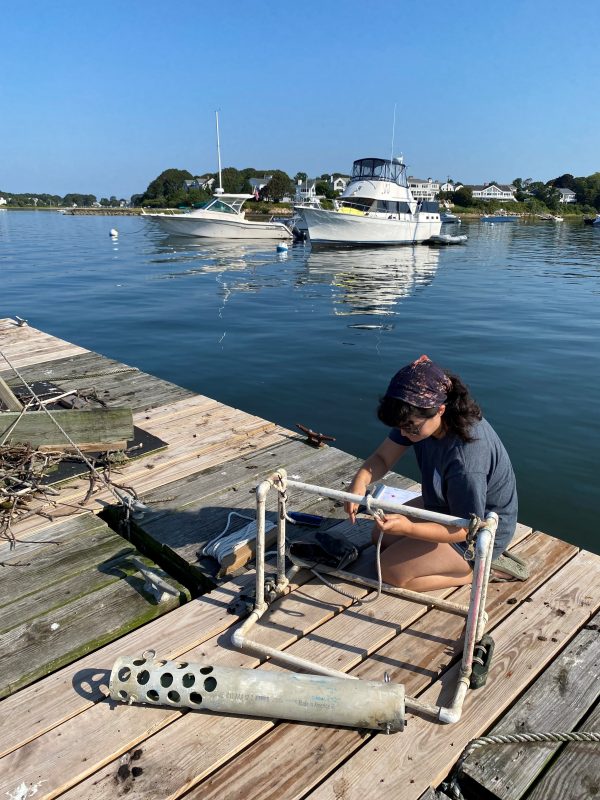Building the Science to Restore Water Quality in Pocasset and Red Brook Harbors and in Apponagansett Bay
 For over 30 years, the Buzzards Bay Coalition water quality monitoring program has tracked trends in water quality throughout the Bay. And for more than half its harbors and coves, the trends are not good. Now the Coalition is working with partners to develop the science necessary to create plans to improve water quality in a couple key areas in Bourne and Dartmouth.
For over 30 years, the Buzzards Bay Coalition water quality monitoring program has tracked trends in water quality throughout the Bay. And for more than half its harbors and coves, the trends are not good. Now the Coalition is working with partners to develop the science necessary to create plans to improve water quality in a couple key areas in Bourne and Dartmouth.
Waters in Buzzards Bay should be clear and rich in oxygen so that fish, shellfish, and eelgrass thrive. In Apponagansett Bay and Pocasset and Red Brook Harbors, water quality has declined due to nitrogen pollution. When too much nitrogen gets into the water, it fuels the growth of algae blooms that lead to murky water, less oxygen, fewer eelgrass beds, and lower fish and shellfish populations. These conditions harm underwater life, but they also make the water pretty unappealing for people, too.
Ten years ago, the state recognized Pocasset Harbor and Red Brook Harbor (including Hen Cove) as having degraded water quality from nitrogen pollution, and even earlier, it identified the nitrogen pollution problem in Apponagansett Bay. Beginning in the early 2000s the Massachusetts Estuaries Project began to develop the science needed to create water quality restoration plans around Southeastern Massachusetts. Unfortunately, when the Massachusetts Estuaries Project ended, it abandoned the science for several Buzzards Bay estuaries including Pocasset and Red Brook Harbors and Apponagansett Bay.
In an effort to collect the science needed to create restoration plans, the Coalition began developing partnerships with scientists and researchers and obtaining state and federal grant funding in order to pick up where the Massachusetts Estuaries Project left off. The Coalition is currently working with partners from the Woods Hole Oceanographic Institution, the Marine Biological Laboratory, and the Buzzards Bay National Estuary Program on quantifying nitrogen pollution in Pocasset/Red Brook Harbor and Apponagansett Bay.
The biggest source of nitrogen pollution to both areas is home septic systems. Traditional septic systems remove bacteria, but do little to remove nitrogen. Nitrogen seeps into the groundwater and ends up in our waterways. When there are lots of homes on septic systems in coastal communities, they become a big problem for the health of our waterways. Other smaller sources of nitrogen include stormwater funneling nitrogen from paved surfaces to waterways when it rains, fertilizer running off lawns and farm fields and burning of fossil fuels, which puts nitrogen oxides into the air that eventually fall back onto the land as acid rain.
Scientists at the Buzzards Bay National Estuary Program are using mapping tools to identify the nitrogen coming from all the sources on land and scientists at the Marine Biological Laboratory are collecting data to determine the amount of nitrogen coming from marine sediments. Oceanographers from the Woods Hole Oceanographic Institution are modeling how ocean tides and currents move the nitrogen once it’s in the water. Coalition scientists will be bringing all this data, along with its water quality monitoring records, together to provide the towns and Massachusetts Department of Environmental Protection (MassDEP) with the information they need to set targets for how much nitrogen Pocasset/Red Brook Harbor and Apponagansett Bay can handle while remaining healthy. Final reports for both harbors will be released in early 2025.
Partial support for this work is being provided by grants from the Southeast New England Program (SNEP), MassDEP, and the Zeien Family Foundation. Federal Funds for the project came from the Environmental Protection Agency (EPA) to MassDEP under a s. 604(b) Water Quality Management Planning Grant and to Restore America’s Estuaries under a SNEP Watershed Implementation Grant. The contents of this article do not necessarily reflect the views and policies of EPA or of MassDEP, nor does the mention of trade names or commercial products constitute endorsement or recommendation for use.